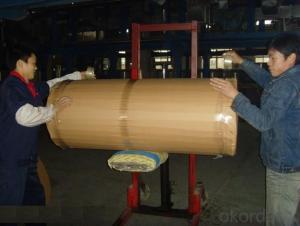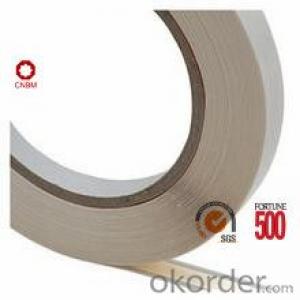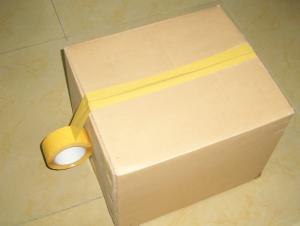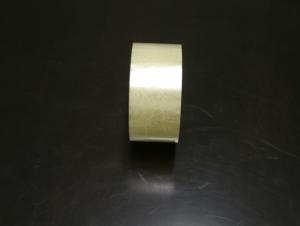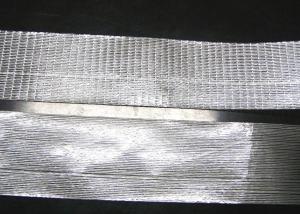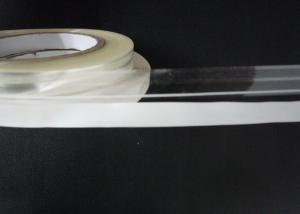A&M Packaging Clear Color BOPP Packing Tape
- Loading Port:
- China Main Port
- Payment Terms:
- TT OR LC
- Min Order Qty:
- -
- Supply Capability:
- -
OKorder Service Pledge
OKorder Financial Service
You Might Also Like
CONSTRUCTION:
Carrier: BOPP film
Adhesive: Water based acrylic adhesive.
TYPICAL PHYSICAL PROPERTIES:
Total Thickness (adhesives + carrier): 40 ± 2 um
Initial Tack (11mm steel ball): ³ 18#
180O Peel Adhesion (to steel): ³ 0.5 kgf /25mm
Holding Power: ³ 24 hrs
Tensile Strength: ³ 30 N/cm
Elongation: ≤180%
PACKING:
Core I.D.: 3” (76mm±1)
Jumbo Roll:1280mm x 4000m
Cut Roll: As per customer’s requirements
Application:
Carton sealing & packing, Light duty packaging, bundling, holding, and other office & household use.
REMARKS:
1. The data above are typical results and subject to change without notice.
2. Tolerance: Weight and Thickness: ±10%; Width: ±3mm;
Length: Cut Roll & Log Roll ±0.3m, Jumbo Roll ±0.5%.
3. The products should be stored at room temperature and be kept away wet and/or heat source.
4. It is essential, as with all pressure-sensitive tapes, that the surface to which the tape is applied must be clean, dry, and free of grease and oil.
5. The users should take test and do trial-application on the above products before coming into application so as to witness and ensure suitability for their special purpose and technique.
- Q: Can packaging tape be used for sealing foam?
- Yes, packaging tape can be used for sealing foam. Packaging tape is commonly used for sealing boxes and packages, but it can also be used effectively to seal foam. When using packaging tape to seal foam, it is important to ensure that the tape is securely adhered to the foam surface to create a tight seal. This can be achieved by applying pressure to the tape after it has been applied. Additionally, it is recommended to use a tape that is specifically designed for sealing foam, as these tapes often have stronger adhesive properties and are more resistant to temperature changes and moisture. Overall, packaging tape can be a convenient and effective option for sealing foam.
- Q: Can packaging tape be used for sealing musical instruments or equipment?
- Packaging tape is not recommended for sealing musical instruments or equipment. While packaging tape is designed to securely seal boxes and packages, it is not suitable for sealing musical instruments or equipment due to several reasons. Firstly, packaging tape may leave residue or adhesive marks on the surface of the instrument or equipment, potentially damaging the finish or the overall appearance. Musical instruments and equipment often have delicate finishes that require special care and attention, and using packaging tape may result in unwanted marks or damage. Secondly, packaging tape may not provide adequate protection or support for fragile or valuable musical instruments or equipment. Musical instruments, especially those made of wood, can be sensitive to changes in temperature, humidity, and pressure. Using packaging tape may not provide the necessary protection to prevent damage during transportation or storage. Instead, it is recommended to use specialized instrument or equipment cases, covers, or bags that are designed to provide proper protection and support. These cases are specifically designed to accommodate the shape, size, and fragility of musical instruments or equipment, ensuring their safety during transportation or storage. If you need to seal a case or cover for musical instruments or equipment, it is advisable to use suitable sealing methods recommended by the manufacturer. This may include zipper closures, Velcro straps, buckles, or other mechanisms designed specifically for securing musical instruments or equipment. In conclusion, while packaging tape can be useful for sealing boxes and packages, it is not suitable for sealing musical instruments or equipment. To ensure the safety and protection of your musical instruments or equipment, it is best to use specialized cases or covers designed for this purpose.
- Q: How do I remove packaging tape without damaging the surface?
- To remove packaging tape without damaging the surface, you can follow these steps: 1. Start by lightly heating the tape using a hairdryer on a low setting. The heat will soften the adhesive, making it easier to remove. 2. Gently lift one corner of the tape using your fingernail or a plastic scraper. Be careful not to use sharp objects that could scratch the surface. 3. Slowly peel the tape back at a 180-degree angle, applying steady and even pressure. If the tape resists, stop and apply more heat to soften the adhesive further. 4. If there is any residue left behind, you can use rubbing alcohol or a mild adhesive remover. Apply a small amount to a soft cloth and gently rub the residue until it lifts off. 5. Once the tape and residue are removed, clean the surface with a mild soap and water solution to remove any remaining adhesive or residue. Remember to always test any cleaning solution on a small, inconspicuous area first to ensure it doesn't damage the surface.
- Q: How does packaging tape adhere to surfaces?
- Packaging tape adheres to surfaces through the use of adhesive materials. The adhesive on packaging tape is typically made from a synthetic rubber or acrylic-based material. These materials are designed to have a strong bonding ability to various surfaces such as cardboard, plastic, or metal. The adhesive on packaging tape works by creating a bond between the tape and the surface it is applied to. When pressure is applied to the tape, the adhesive material spreads and makes contact with the surface. This contact allows the adhesive to interact with the surface's molecules, creating a bond through intermolecular forces. The most common type of adhesive used on packaging tape is pressure-sensitive adhesive (PSA). PSA is designed to stick to surfaces with the application of light pressure. When pressure is applied, the adhesive material flows and conforms to the surface, creating a strong bond. The adhesive on packaging tape is also designed to be resistant to various environmental factors such as temperature, humidity, and moisture. This ensures that the tape remains securely adhered to the surface even under challenging conditions. In summary, packaging tape adheres to surfaces through the use of adhesive materials, typically synthetic rubber or acrylic-based. These adhesives create a bond between the tape and the surface through intermolecular forces, allowing the tape to stick securely.
- Q: Can packaging tape be used for sealing glass containers?
- Indeed, glass containers can be sealed using packaging tape. Packaging tapes are specifically engineered to offer a robust and reliable seal on diverse surfaces, glass included. When applied correctly, the tape adheres firmly to the glass, forming a secure seal that safeguards the container's contents. Nonetheless, it is crucial to acknowledge that not all packaging tapes are suitable for glass containers. It is advisable to utilize a tape explicitly designed for glass or a heavy-duty packaging tape with exceptional adhesive properties to guarantee an effective seal.
- Q: What are the considerations for using packaging tape on wooden surfaces?
- When using packaging tape on wooden surfaces, it is important to consider the type of tape being used and its adhesive properties. Opt for a tape specifically designed for use on wood to prevent any potential damage or residue. Additionally, ensure that the wooden surface is clean and dry before applying the tape to ensure proper adhesion. It is also advisable to test a small, inconspicuous area of the wood first to ensure that the tape does not cause any discoloration or damage.
- Q: I'd like to know the specifications of the sealing tape. How do you see it? (the following two examples) product name: sealing tape product type: 2.5 inch product specifications: 57mm*80 code (8.5mm thick) weight: about 0.145KG the price for volume: Specifications: code number 48mm*150 meters *40u flesh 20mm here refers to what? I know that 40U means stickiness, so how do I see that?
- 48mm refers to the width of the tape, 150 meters /80 yards, refers to the length of plastic bags (one yard =0.9144 meters)
- Q: Can packaging tape be used for sealing pet food or treats?
- Yes, packaging tape can be used for sealing pet food or treats. It provides a strong and secure seal to keep the contents fresh and protected. However, it is important to ensure that the tape used is safe for pets, meaning it should be non-toxic and not contain any harmful substances that could potentially be ingested by the animals. It is recommended to use pet-safe packaging tape specifically designed for sealing pet food or treats, as it meets the necessary safety requirements and regulations.
- Q: I saw a lot of different sizes of sealing tape on the Internet. Some are very thick and some are thin. Will the thickness of the same number be the same in the same number of yards? Some 100Y have around 1.5cm of the flesh, but some 100Y only about 0.7cm of the flesh, what is this possible? Or is it true or false? Ask the personage inside course of study to help solve!
- I saw a lot of different sizes of sealing tape on the Internet. Some are very thick and some are thin. Will the thickness of the same number be the same in the same number of yards? Some 100Y have around 1.5cm of the flesh, but some 100Y only about 0.7cm of the flesh, what is this possible? Or is it true or false? Ask the personage inside course of study to help solve!
- Q: How does packaging tape perform on low-friction surfaces?
- Packaging tape generally does not perform well on low-friction surfaces. Low-friction surfaces, like smooth plastics or certain types of laminates, lack texture and adhesion, making it challenging for packaging tape to effectively stick and hold. The lack of friction allows the tape to easily slide or peel off the surface, compromising the integrity of the package. In such cases, it is advisable to use alternative methods like shrink wrapping, heat sealing, or adhesive sprays specifically designed for low-friction surfaces. These alternatives provide better adhesion and ensure the package remains securely sealed during handling and transportation.
Send your message to us
A&M Packaging Clear Color BOPP Packing Tape
- Loading Port:
- China Main Port
- Payment Terms:
- TT OR LC
- Min Order Qty:
- -
- Supply Capability:
- -
OKorder Service Pledge
OKorder Financial Service
Similar products
Hot products
Hot Searches
Related keywords









